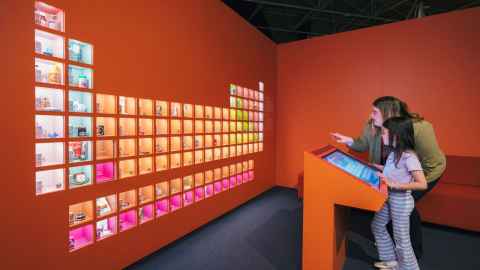From prototype at Unleash Space to 'Museum Oscar'
19 June 2025
An interactive periodic table at MOTAT’s new Te Puawānanga Centre began as a student concept at the University of Auckland's Unleash Space.

An interactive periodic table that is one part of the new Te Puawānanga science and learning centre at Auckland’s Museum of Transport and Technology (MOTAT) was first conceptualised at Unleash Space, the innovation hub run by the University of Auckland Business School’s Centre for Innovation and Entrepreneurship (CIE).
Te Puawānanga was recently awarded International Exhibition of the Year at the “Oscars of the museum world”, the Museum and Heritage Awards, held in London.
Julie Baker is the Head of Education at MOTAT and was instrumental in the development of Te Puawānanga. She says, “The periodic table was my baby from the get-go, so holds a piece of my heart.”
Julie and her colleagues developed Te Puawānaga for families, but also as a resource for teachers to support them in teaching the Science and Technology curricula. The project team drew inspiration from a variety of research and STEM practitioners.
Staff at MOTAT consulted with an assortment of staff and alumni from Waipapa Taumata Rau, University of Auckland for some of the development of the new exhibition. The interactive periodic table that forms part of the display is based on an early iteration that was created by CIE alumnus Hayden Moore.
Hayden says: "While studying, I took a huge range of papers to cover my broad interests, including physics, chemistry, earth science and my major, computer science. One of the first papers I took was Physics 140 and I still regard it as the best and most influential paper I took at uni. It introduced me to binary, logic, datasheets, microcontrollers and more.”
As a student, Hayden worked as a Creative Technologist at CIE’s innovation hub Unleash Space, teaching other students and staff how to use a range of technology. He was also able to make use of the maker space’s facilities and resources, such as the Arduino electronics station, for his own projects.
“The custom periodic table display case I made for my element collection had a multi-coloured LED in each cell, which I could light up on demand from a phone app through Bluetooth to make it super interactive," he says. "At one point, I brought the element collection into a primary school to teach chemistry. This project brought me in touch with Julie. I’m thrilled that it was the prototype for what’s now on display at MOTAT."
“The periodic table exhibition at MOTAT has an interactive digital display where visitors can ‘interrogate’ the periodic table," says Julie. "Users can remotely light up different elements and interact with the digital display to learn more about that element or group of elements.
"To make the exhibition really dynamic, we’ve incorporated a range of common household items as well as unexpected or ‘dangerous’ elements. Kids love the shock value.”
The periodic table display is one of many carefully considered interactive displays in Te Puawānanga, which has also been designed with an ambition to incorporate Māori knowledge. The name derives from the Māori kupu for the clematis flower, a climbing vine. Meaning ‘a place to blossom and learn’, staff at MOTAT aim to enable visitors to thrive and flourish.
After graduating from the University of Auckland, Hayden worked in industry before returning to the University to work as CIE’s Technology and Prototyping Adviser for a couple of years. He was then offered a role as a programme manager at a university in Sydney.
“I’m looking forward to coming back to visit Auckland and see the periodic table in person. I can’t wait.”
Contact:
Questions? Contact the Centre for Innovation and Entrepreneurship for more information.
E: cie@auckland.ac.nz